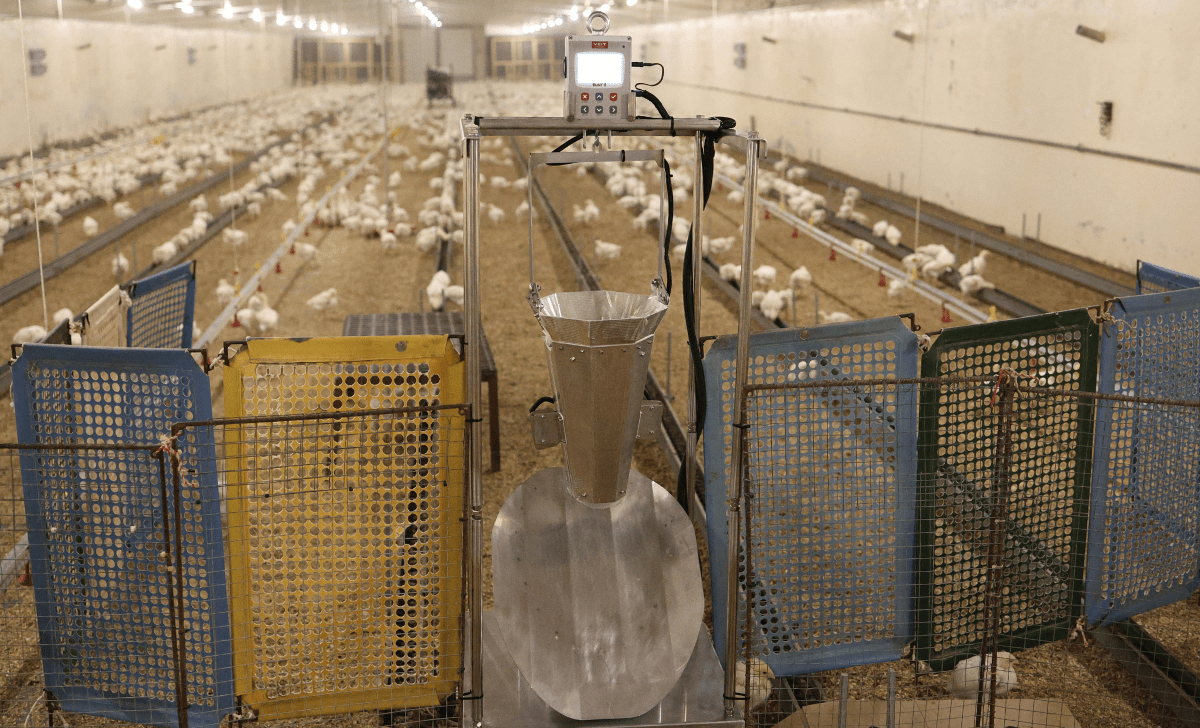Poultry processing automation is transforming how producers manage live birds, with automated sorting emerging as a critical technology for layer and parent stock operations. Modern automated poultry sorting systems address the industry’s most pressing challenges: ensuring product consistency while decreasing labor requirements.
The Critical Role of Live Bird Sorting
Unlike broiler production, layer and parent stock operations require precise weight-based sorting to achieve uniform flocks. Research by Mels et al. (2023) demonstrates that flock uniformity directly impacts production performance, with uniform flocks reaching egg production peaks earlier and maintaining higher productivity throughout lay cycles. Poultry grading technology enables producers to separate birds by weight categories, creating more consistent groups that respond uniformly to feeding and management programs.
Weighing and sorting machines like the BAT1 manual poultry scale provide the foundation for effective sorting operations. These specialized poultry scales deliver accuracy within 1 gram for live birds, automatically calculating critical statistics including coefficient of variation, average weights, and uniformity. After weighing each bird, the BAT1 gently drops it onto the BAT1 Sorting Machine, which directs it into appropriate pens based on predetermined weight categories.
Automation Drives Measurable Efficiency Gains
Automated weighing systems deliver measurable operational efficiency gains across multiple metrics. According to Castro et al. (2023), precision livestock farming technologies enable real-time monitoring and assessment, reducing human error while improving decision-making speed. The BAT scale system eliminates manual data recording, preventing falsified entries and ensuring data integrity throughout the weighing process.
Data collection in poultry operations is „time-consuming, labor-intensive, and subject to human errors“ (Castro et al., 2023). Single-person operation becomes feasible with poultry processing automation, every BAT scale automatically records weight entries and calculates essential statistics. The integrated software calculates uniformity percentages automatically, providing immediate feedback on flock composition without manual calculation requirements.
Technology Integration and Future Outlook
For added efficiency and reliability, modern poultry operations incorporate IoT connectivity and cloud-based analytics. Numerous BAT scale models offer WiFi and other advanced connectivity options, enabling real-time data transfer to farm management systems. This connectivity allows producers to monitor operations remotely and integrate weighing data with broader production analytics.
Poultry industry paradigms continue evolving toward precision agriculture approaches. Zuidhof et al. (2017) demonstrate that insight-driven feeding combined with accurate sorting can improve feed conversion efficiency and production uniformity. As labor costs rise and skilled workers become scarce, intuitive automated sorting represents a strategic investment in operational sustainability.
Poultry sorting automation transforms traditional manual processes into data-driven operations that deliver consistent results while reducing operational costs. For layer and parent stock producers seeking competitive advantages, automated sorting systems like the BAT1 Sorting Machine provide measurable returns through improved efficiency, reduced labor requirements, and enhanced flock uniformity.
Sources:
Mels, C., Niebuhr, K., Futschik, A., Rault, J.L., & Waiblinger, S. (2023). Development and evaluation of an animal health and welfare monitoring system for veterinary supervision of pullet farms. Preventive Veterinary Medicine, 217, 105929.
Castro, F.L.S., Chai, L., Arango, J., Owens, C.M., Smith, P.A., Reichelt, S., DuBois, C., & Menconi, A. (2023). Poultry industry paradigms: connecting the dots. Journal of Applied Poultry Research, 32(2), 100310.
Zuidhof, M.J., Fedorak, M.V., Ouellette, C.A., & Wenger, I.I. (2017). Precision feeding: Innovative management of broiler breeder feed intake and flock uniformity. Poultry Science, 96(7), 2254-2263.
